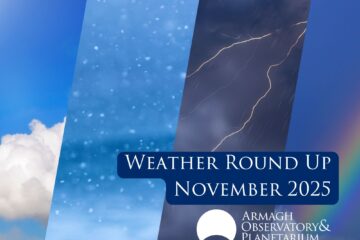Article by: Professor Simon Jeffery
In a new paper, Simon Jeffery reports the discovery of standing waves on two small hot stars similar to the pattern of jet streams seen in the Earth’s atmosphere.
In Ireland, we’re never stuck for a topic of conversation; the weather changes all the time. Why is that? Turns out that Ireland sits at a latitude where cold air flowing south from the North Pole and warm air returning north form the tropics are twisted by the Earth’s rotation to set up a standing wave. Although ‘standing’, the air is not stationary; jet streams run along this hot/cool boundary, forming a big north-south wave which rotates slowly around the Earth’s poles. Depressions and anticyclones develop above and below this pattern and create our ‘weather’.
If you were to look a the Earth’s jet stream from outer space, you would see the wave moving around at the same time as the Earth rotates. Since there are an integer number ’n’ crests or troughs in the wave, you would measure a frequency of ’n’ crests per day. For comparison, you would measure the Earth’s rotation frequency to just less than be 1 per day (1,2)

These waves are known as Rossby waves, or planetary waves, and occur naturally in rotating fluids. Nearly 40 years ago, Japanese astronomer Hideyuki Saio predicted that these waves would also occur in stars. Now stars don’t have hot equator and cold poles, but if they are rotating sufficiently fast they get flatter and hotter at the poles and wider and cooler at the equator. So Saio calculated that there could be Rossby waves, or ‘r modes’ set up in the atmospheres of rotating stars, and that these could be visible as tiny variations in emitted light.
About the same time, astronomer Simon Jeffery started to make observations of extremely helium-rich stars. His first ever astronomical observations were made with the Leslie Rose Telescope at the University Observatory, St Andrews, Scotland in 1983. Only two ‘helium stars’ were visible in the northern hemisphere winter, being the hot subdwarfs BD+37 442 and BD+37 1977. Simon saw no light variations at all from St Andrews. 35 years later, after moving to Armagh and setting up the Armagh Robotic Telescope, Simon again looked for light variations in BD+37 1977. Again, he found nothing.
Meanwhile, the Terrestrial Exoplanet Survey Satellite (TESS) had been sent to stare at large sections of the sky for nearly 30 days at a time. Without the interference of the Earth’s atmosphere and with the long stare time unaffected by a day-night cycle, TESS is able to detect tiny variations that are invisible from the ground. This is great for hunting for planets, but also great for observing other weak signals from stars. Indeed, using data from space, Saio and co-workers recently discovered r modes on a great variety of stars.

In late 2019 TESS observed both BD+37 442 and BD+37 1977. When Simon found the light curves, he was astonished to see both stars showed periodic variations with amplitude about 1 per cent and with frequencies roughly two and one per day respectively. He also noticed additional frequencies or ‘harmonics’ in the light curve.

Some possible causes could be discounted; the influence of a companion star because the stars themselves are not moving in an orbit, and spots, because the harmonics are not quite perfect and the wave patterns appear to drift. So the variation must be an intrinsic oscillation on the star’s surface. Normal pulsations would occur at much higher frequencies on these compact stars. There was already evidence that BD+37 442 was rotating rapidly, with a frequency of about 1 per day. The expected frequencies of r-modes would be harmonics of the rotation frequency, pretty much as found.
So it seems that BD+37 442 and BD+37 1977 could be hot subdwarfs with weather.
Notes.
- The Earth makes one full revolution in 23 hours and 56 minutes, but as it also moves around its orbit at the same time, the Sun appears overhead every 24 hours.
- Frequency is the inverse of period, so a frequency of two per day corresponds to a period of half a day.
Based on the paper:
TESS photometry of helium-rich hot subdwarfs: r modes in BD+37 442 and BD+37 1977By C. Simon Jeffery, 2020, MNRAS (in press: DOI: 10.1093/mnras/staa1555, ArXiV: 2006.00950)



0 Comments